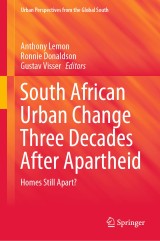Details

South African Urban Change Three Decades After Apartheid
Homes Still Apart?GeoJournal Library
|
139,09 € |
|
| Verlag: | Springer |
| Format: | |
| Veröffentl.: | 10.06.2021 |
| ISBN/EAN: | 9783030730734 |
| Sprache: | englisch |
Dieses eBook enthält ein Wasserzeichen.
Beschreibungen
<p>This book provides an analysis of South African urban change over the past three decades. It draws on a seminal text, Homes Apart, and revisits conclusions drawn in that collection that marked the final phases of urban apartheid. It highlights changes in demography, social as well as economic structure and their differential spatial expression across a range of urban sites in South Africa. The evidence presented in this book points to a very complex set of narratives in urban South Africa and one that cannot be reduced to a singular statement so the conclusions of the various investigations are in many ways open. As urban apartheid represented one clear outcome, its post-apartheid urban legacies varies greatly from city to city. As such this book is a great resource to students and academics focused on urban change in South African cities since the demise of apartheid, and scholars of urban policy-making in South Africa and Southern urbanists generally. </p>
1. The apartheid city – Anthony Lemon.- 2. Cape Town: living closer, yet, somehow further apart – Gustav Visser & Anele Horn.- 3. Johannesburg three decades after the end of the Group Areas Act: repetitions and disruptions of spatial patterns - Richard Ballard, Christian Hamann, Thembani Mkhize.- 4. Durban: Betraying the struggle for a democratic city? – Brij Maharaj.- 5. Pretoria-Tshwane: Past, Present and Future - Andre Horn.- From East London to Buffalo City Metropole – Cecil Seethal, Etienne Nel & John Bwalya.- 7. Bloemfontein-Mangaung – Lochner Marais.- 8. Pietermaritzburg – Adrian Nel, Marc Epprecht & Rob Haswell.- 9. Polokwane: South Africa’s most integrated city? – Ronnie Donaldson.- 10. From Grahamstown to Makhanda: Urban frontiers and challenges in a post-apartheid city – Phillipa Irvine.- 11. Mthatha (Umtata): From tribal buffer, to homeland capital, to regional integration – Manfred Spocter & Ronnie Donaldson.- 12. Mahikeng: one city but worlds apart – Verna Nel & James Drummond.- 13. Kimberley: The diamond city has lost its sparkle – Manfred Spocter.- 14. Alice: change in a small university town - John Ntema.<div><br></div>
<div><div><div>Anthony Lemon is an Emeritus Fellow of Mansfield College, Oxford and lectured in Geography at Oxford University until he retired in 2010. He has held research fellowships and lectureships at several universities in South Africa and Zimbabwe and has authored or edited six books including Homes Apart: South Africa's Segregated Cities (1991) which this volume revisits. He has published nearly a hundred journal papers and book chapters reflecting specific research interests including small states, regional integration, desegregation and resource allocation in South African schools, electoral geography and democratic consolidation, Indian identities, urban residential segregation/desegregation in South Africa and local government. In 2002 he was elected to an honorary Fellowship of the Society of South African Geographers. </div> </div><div>Ronnie Donaldson is Professor in the Department of Geography and Environmental Studies at Stellenbosch University, SouthAfrica. He previously held positions at the University of the North, Vista University, and the University of the Western Cape. He specialises in urban and tourism development. He has published more than 100 academic journal and chapter articles, five edited books, and a sole-authored book in 2018, Small Town Tourism in South Africa. His current research interests are small island and small town tourism geographies, and South African urban spatial developmental challenges. Currently funded research projects focus on artwashing and gentrification in Cape Town and Johannesburg. </div><div> </div><div>Gustav Visser is Professor in the Department of Geography and Environmental Studies at Stellenbosch University, South Africa. He joined the University of the Witwatersrand in 2000 as Postdoctoral Fellow after which he was appointed Lecturer in the Department of Geography at the University of the Free State in 2002. He is an urban geographer by training. He completed his undergraduate education at Stellenbosch University and received his doctorate from the London School of Economics and Political Science, focusing on the spatialities of social justice theorisation in post-apartheid cities. These interests have been communicated in six books and over 130 academic articles and book chapters.</div><div>Currently funded research deals with queer sexualities, as well as the tourism and development nexus. He is past treasurer and president and now fellow of the Society of South African Geographers. He serves on the editorial boards of several academic journals and is a book series editor for Springer.</div></div><div><br></div>
<p>This book provides an analysis of South African urban change over the past three decades. It draws on a seminal text, Homes Apart, and revisits conclusions drawn in that collection that marked the final phases of urban apartheid. It highlights changes in demography, social as well as economic structure and their differential spatial expression across a range of urban sites in South Africa. The evidence presented in this book points to a very complex set of narratives in urban South Africa and one that cannot be reduced to a singular statement so the conclusions of the various investigations are in many ways open. As urban apartheid represented one clear outcome, its post-apartheid urban legacies varies greatly from city to city. As such this book is a great resource to students and academics focused on urban change in South African cities since the demise of apartheid, and scholars of urban policy-making in South Africa and Southern urbanists generally. </p>
Reviews South African cities thirty years after the scrapping of apartheid Showcases the way in which cities have managed to rid its apartheid legacy Investigates the extent and spatial patterns of desegregation in post-apartheid cities
Diese Produkte könnten Sie auch interessieren:

Der Aufstand der Jugendlichen in den Banlieues: Eine Analyse der Pariser Unruhen von 2005

von: Ahmed El- Mamouni

23,00 €















